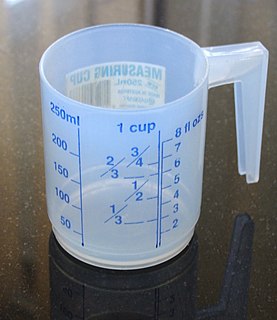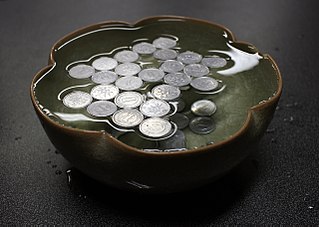Oil is any of a number of nonpolar, hydrophobic, and viscous liquids.
A burette is a graduated glass tube with a tap at one end, for delivering known volumes of a liquid, especially in titrations. It is a long, graduated glass tube, with a stopcock at its lower end and a tapered capillary tube at the stopcock's outlet. The flow of liquid from the tube to the burette tip is controlled by the stopcock valve. There are two main types of burette; the volumetric burette and the Piston burette.

A graduated cylinder, also known as a measuring cylinder or mixing cylinder is a common piece of laboratory equipment used to measure the volume of a liquid. It has a narrow cylindrical shape. Each marked line on the graduated cylinder represents the amount of liquid that has been measured.

Surface tension is the tendency of liquid surfaces at rest to shrink into the minimum surface area possible. Surface tension is what allows objects with a higher density than water such as razor blades and insects to float on a water surface without becoming even partly submerged.
Phase or phases may refer to:

The meniscus is the curve in the upper surface of a liquid close to the surface of the container or another object, caused by surface tension.
Cache, caching, or caché may refer to:

Cohesion, also called cohesive attraction or cohesive force, is the action or property of like molecules sticking together, being mutually attractive. It is an intrinsic property of a substance that is caused by the shape and structure of its molecules, which makes the distribution of surrounding electrons irregular when molecules get close to one another, creating electrical attraction that can maintain a microscopic structure such as a water drop. In other words, cohesion allows for surface tension, creating a "solid-like" state upon which light-weight or low-density materials can be placed upon.

A measuring cup is a kitchen utensil used primarily to measure the volume of liquid or bulk solid cooking ingredients such as flour and sugar, especially for volumes from about 50 mL (2 fl oz) upwards. Measuring cups are also used to measure washing powder, liquid detergents and bleach for clothes washing. The cup will usually have a scale marked in cups and fractions of a cup, and often with fluid measure and weight of a selection of dry foodstuffs.
Plasma or plasm may refer to:
In the physical sciences, an interface is the boundary between two spatial regions occupied by different matter, or by matter in different physical states. The interface between matter and air, or matter and vacuum, is called a surface, and studied in surface science. In thermal equilibrium, the regions in contact are called phases, and the interface is called a phase boundary. An example for an interface out of equilibrium is the grain boundary in polycrystalline matter.

In fluid mechanics, the Cheerios effect is a colloquial name for the phenomenon of floating objects appearing to either attract or repel one another. The example which gives the effect its name is the observation that pieces of breakfast cereal floating on the surface of a bowl will tend to clump together, or appear to stick to the side of the bowl.

The alcohol thermometer or spirit thermometer is an alternative to the mercury-in-glass thermometer and has similar functions. Unlike the mercury-in-glass thermometer, the contents of an alcohol thermometer are less toxic and will evaporate quickly. The ethanol version is the most widely used due to the low cost and relatively low hazard posed by the liquid in case of breakage.
Disjoining pressure, in surface chemistry, according to an IUPAC definition, arises from an attractive interaction between two surfaces. For two flat and parallel surfaces, the value of the disjoining pressure can be calculated as the derivative of the Gibbs energy of interaction per unit area in respect to distance. There is also a related concept of disjoining force, which can be viewed as disjoining pressure times the surface area of the interacting surfaces.
This page is based on this
Wikipedia article Text is available under the
CC BY-SA 4.0 license; additional terms may apply.
Images, videos and audio are available under their respective licenses.






